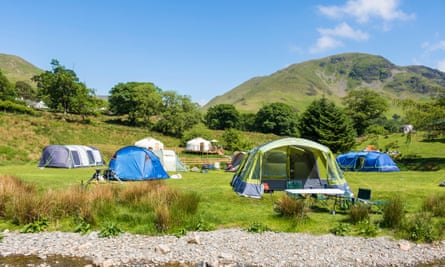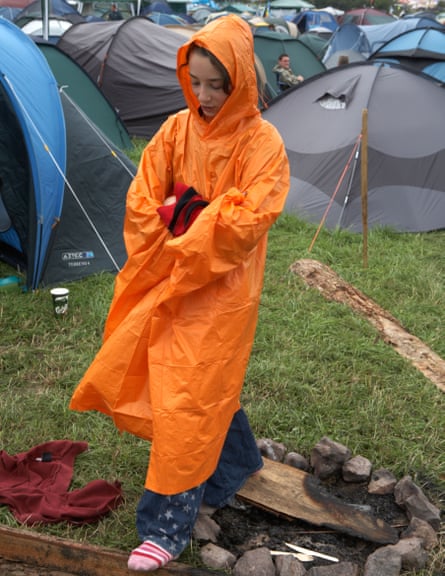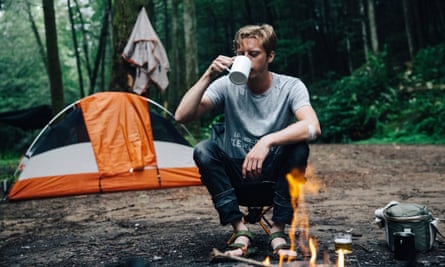[ad_1]
Forecast: heat
Everyone prays for sunshine, but camping in a heatwave can be a health risk. David Scotland, the owner of Outdoor World Direct, says: “Avoid taking naps in your tent during the day as this can lead to heatstroke, as one of my friends discovered at Glastonbury!”
To combat the heat, Scotland suggests buying a TC/polycotton tent, which is breathable, ideally with UV protection and blackout bedrooms. Combine this with a lightweight summer sleeping bag (1-2 season rating). “Anything higher than this will be uncomfortable.” He also recommends a solar camping fan for hot spells.
Max Schmidt, from the tour operator CamperDays, suggests buying a cooling mat to sleep on. “When body pressure, weight and motion are applied, a gel inside the mat is activated, which will absorb body heat and reduce body temperature,” he says. “It provides an instant cooling sensation to ensure a comfortable sleep on a balmy night.”
If sleeping on a traditional airbed, Scotland says it will need topping up each night as hot air causes it to deflate.

Thomas Drake, the founder of CampStead, advises pitching in a spot that is shaded from the midday sun. “Plan to pitch somewhere where the sun is hitting your tent from early morning to around 11am, then from 3pm onwards,” he says. If this isn’t possible, he suggests using a reflective tent cover.
If sleeping with the tent open on hot nights, Drake recommends buying a net attachment: “These act in a mosquito net fashion, keeping cool air flowing but keeping unwelcome insects out.”
Drake’s other must-have is a cool box. “Even if you don’t have access to ice, just keeping your food and drink in a cool box will do wonders for keeping things fresh for at least your first couple of nights,” he says. “To combat the heat even further, apply tinfoil to the roof of the box to reflect the heat.” Becky Masih, of campsites.co.uk, suggests taking frozen bottles of water or milk to use as ice blocks that can be drunk as they melt.
If you’re camping at a festival or at a no-frills site, Dan Yates, the founder of Pitchup, suggests leaving a few bottles of water in the sun to warm up. After a couple of hours, they will be ready for a lukewarm DIY shower. “Maintaining a cool and comfortable body temperature is crucial when camping in hot weather,” says Yates.
Schmidt has a word of caution. “You may have heard that hanging up wet towels in tents can keep interiors cool, but this only works if the towels are 100% cotton,” he says. “In any case, this creates a humid atmosphere that can lead to a buildup of mould.” Best keep those towels for drying off after a cooling swim.
Forecast: rain
If you’re well prepared, rain doesn’t have to ruin your camping trip. To withstand heavier rain, “Look for a tent with a minimum of 3,000mm hydrostatic head value – 5,000mm is even better – which should prevent leaks,” says Scotland. You could also consider a carpet and footprint for your tent; some come with these as part of a bundle. “A footprint adds an additional layer of protection from the wet ground and a carpet offers insulation and homeliness to the interior.”

Another helpful feature is a porch. “Some tents have a porch or pre-attached awning that provides a covered seating/dining area ideal for wet conditions,” says Scotland. “In the absence of such features, tarps are inexpensive, offer shelter and can be erected easily, even using walking poles.”
Ali Paice, the founder of Bert’s Kitchen Garden campsite, is also a fan of tarps. “Gazebos might seem like a good idea, but they’re not designed for exposed places like a camping field,” she says. “Try a tarp instead – I like Snow Peak’s Amenity Tarp – which will provide you with the shelter from sun and rain and is designed for the landscape.”
Drake suggests pitching under trees if possible, which will provide some protection from the rain. Failing that, “It is a great help to set up a diagonal, open awning over your tent that will shelter it and direct rainfall away from your pitch area.” Drake’s other top tip is lining backpacks and tent bags with bin liners to prevent a premature soaking.
Scotland warns that biting insects love mild, wet conditions. “I recommend keeping your fly sheets zipped and taking insect repellent and bite relief,” he says.
If the rain stops before you leave, let your tent dry out on the campsite before packing it away. If not, pitch it back home so you can clean it, air it and make any repairs. “This prevents mould and bad smells from developing, which ruins the tent,” says Scotland.
Forecast: wind
Wind is probably the most dangerous weather for campers. “If the forecast is saying high winds, gale-force winds or severe weather warning, I strongly recommend arranging alternative accommodation or rebooking your trip. Sometimes we just have to accept defeat,” says Scotland. “If high winds greet you unexpectedly at night, use your car as a windbreak or seek emergency shelter in your vehicle.”
However, an ordinarily gusty day can be dealt with. “If you’re heading to a location that is more exposed to wind, such as those on the coast, look for a tent that has Tension Band System (TBS) II, which offers extra stability,” says Scotland.
Drake suggests sleeping in a smaller tent than usual, as bigger ones catch the wind more easily. He also advises setting up your tent with the lowest side facing the main direction of the wind, as this reduces surface area and lowers the chances of it becoming airborne. Try to find a sheltered pitch, and ensure all pegs are hammered down at 45-degree angles as tightly as possible. Peg two guy ropes at the corners. When sleeping, lie with your head or feet in the direction of the wind, to ensure less tent movement throughout the night.
Useful equipment includes a tent repair kit, in case of damage from flying debris, and a camping fire guard to protect your stove or campfire.
Forecast: cold
Camping can be cosy during an unseasonable cold snap – with a bit of planning. Drake says pitch location is important: “A bordered pitching area will shield your tent from any cold breezes that may sweep through the campsite. It will also be key to keeping your campfire going.”

He recommends packing lots of layers, ideally cotton or wool, to maintain heat and avoid sweating. Hand warmers can be used to heat sleeping bags, says Drake: “Place one at the foot of the bag, one in the middle and one in the neck – this is the outdoor enthusiast’s answer to an electric blanket!”
Yates suggests putting your clothes for the next day inside the bag with you, so they’re warm when you put them on in the morning. A hot-water bottle wouldn’t hurt either, and you could add a (non-electric) blanket on top – the best are made from sheep’s wool – or even consider investing in solar- or battery-powered heaters.
Finally, Drake says, bring or collect plenty of firewood and kindling to start your campfire and maintain it. As Masih says, “No camping trip is complete without hot chocolate and marshmallows.” And no one cares about the cold when they’re toasting marshmallows over a fire.
[ad_2]
Source link